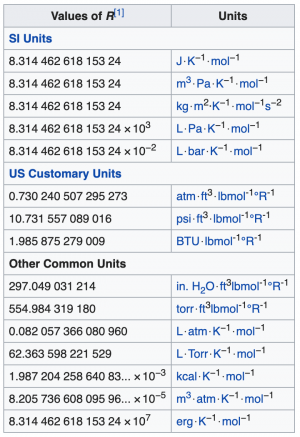Difference between revisions of "Ch5 Lec 3"
| Line 36: | Line 36: | ||
| − | + | Nearly all gases behave similarly when under a set of conditions (P, V, and T). So much so that we define a set of conditions, "standard temperature and pressure" (STP) as T = 273.15 K and P = 1 atm. Under STP, the volume of 1.00 moles of gas is 22.4 L. This concept was discussed in the crash course video. | |
| − | |||
:[[File:Screen Shot 2020-03-29 at 11.20.53 AM.png|300px|thumb|center|from Crash Course]] | :[[File:Screen Shot 2020-03-29 at 11.20.53 AM.png|300px|thumb|center|from Crash Course]] | ||
Revision as of 20:58, 30 March 2020
in progress...
Ideal Gas Law Equation (Sec 5.4)
When combining all of the gas laws, Boyles, Charles', and Avogadro's we get the Ideal Gas Law Equation: As with any mathematical relationship/equation, if there are 5 variables (P, V, n, R, T) all you need to know is 4 of them and the 5th can be calculated.
R, the gas constant is equal to (depending on the units):
Question 1
If given the following data, which gas constant would you use?
- P = 1.12 atm
- V= 2.45 L
- n = 1.00 moles
- T = 298 K
If the volume was not given in the question above, show how it can be calculated:
- P = 1.12 atm
- n = 1.00 moles
- T = 298 K
- R = 0.082057 l*atm/(mol*K)
Calculate V and make sure your work shows how the units cancel:
Question 2
If given the V, n, and T, which gas constant would you use if you want to calculate the pressure in "bar"?
Given:
- V= 22.414 L
- n = 1.0000 moles
- T = 273.15 K
- R = from above...
Calculate the pressure in bar and make sure your work shows how the units cancel:
Nearly all gases behave similarly when under a set of conditions (P, V, and T). So much so that we define a set of conditions, "standard temperature and pressure" (STP) as T = 273.15 K and P = 1 atm. Under STP, the volume of 1.00 moles of gas is 22.4 L. This concept was discussed in the crash course video.


